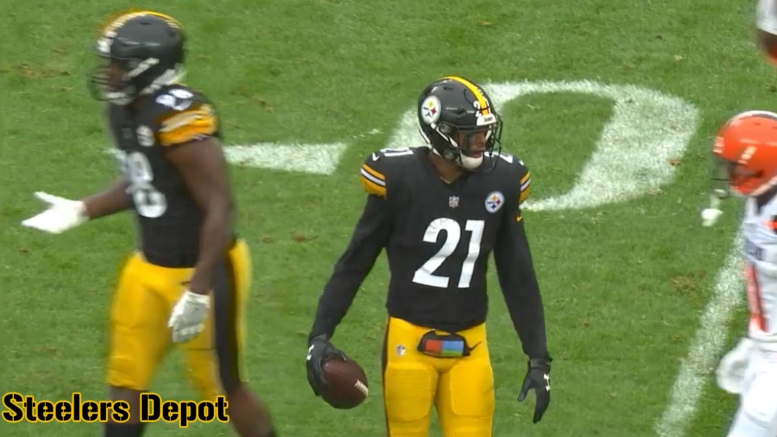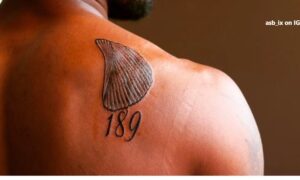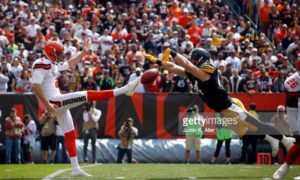It’s said a draft class can’t be fully graded until at least three years after the picks are made. That’s why after submitting grades for every Pittsburgh Steelers pick made in 2021, I began going back through and grading previous Steeler draft classes beginning with 2018. Today continues the third class in that exercise, with the Steelers’ second-round pick in the 2016 NFL Draft: Sean Davis, a safety out of Maryland.
This exercise follows the six viewpoints (listed below) for examining and re-grading a pick. Each of the first five viewpoints gets examined and assigned a letter grade, before taking that analysis and combining it into a final letter grade. Those five viewpoints comprise much of what goes into the draft grades consumed by so many every year after the draft.
Steelers’ Career: What did the player contribute to the team that drafted him?
NFL Career: Did the player make the pick look better in hindsight after leaving Pittsburgh?
Pick Value: Did the player outperform his draft slot? Did he fail to live up to the pick used on him?
Positional Value: Was the player the best player remaining at his specific position in the draft?
Other Options: Did any players go during the next round that were better selections?
Overall Grade: A final mark to denote whether the selection was an overall positive one, or one better spent elsewhere.
Each factor in a retrospective doesn’t apply evenly to every pick made; consider the grades weighted. For example, to return a high grade in pick value, a first-round pick should have a long and impactful career, while a later-round pick needs only a couple seasons as a back-up or modest contributor to be worth the selection used on him.
Some factors are universal, though. Whether picked first overall or 259th, there will always be other options on the board to compare the player to, and steals and reaches can come from any place in the draft.
Round 2, Pick 27: Sean Davis, S, Maryland
STEELERS CAREER: C+
So bad was the Steelers’ secondary after the 2016 season that the team doubled up on it with their first two picks of the 2016 draft. And like first-rounder Artie Burns, Davis quickly worked his way into the lineup. He started nine games as a rookie, and then spent his next two seasons as the team’s full-time starter. In that time, he started at both safety spots.
All three seasons saw at least 70 tackles made, peaking with 92 of them in 2017. Seven came for a loss, another career-best, and Davis set personal bests with three interceptions, eight passes defensed, and a forced fumble. It was a good start to his career, with good flashes offsetting the problems that came with shifting position to position and not finding a set home on defense.
His performance did enough to inspire some hope, but not prevent Pittsburgh from addressing the safety position. The team selected Terrell Edmunds in the first round of the 2018 NFL Draft prior to Davis’ third season. When Davis suffered a season-ending injury to begin 2019, Pittsburgh traded for Minkah Fitzpatrick and elected to allow Davis to test free agency.
After a failed signing elsewhere (see next section), Davis returned to the Steelers in time to play in all 16 games for them in 2020, for just over $900,000. Shifted to a backup role behind the aforementioned Fitzpatrick and Edmunds, Davis played only 57 defensive snaps. He recorded 12 tackles, a pass defensed, and a fumble recovery, and played nearly four times as many special teams snaps as he did for the Steelers’ defense.
NFL CAREER: F
Hitting free agency, Davis landed a one-year contract with the Washington Football Team as a contender to start for them in 2020. Even earning a $5 million deal for that season and receiving a $2 million signing bonus, Davis played poorly enough that Washington cut him before Week 1. Davis gets another chance at success outside of Pittsburgh this season, signing a one-year deal with the Indianapolis Colts this offseason to join a busy Colts’ depth chart for backup safeties.
PICK VALUE: B-
Coming only a few slots before the start of the third round, getting a three-year starter at the safety position isn’t a horrendous return. Especially considering that, without his season-ending injury in 2019, Davis had a legitimate chance to earn a nice payday as a free agent, or in re-signing with the Steelers.
He never reached a Pro Bowl level or signed that second long-term contract with the team. Davis did, though, offer Pittsburgh serviceable play at safety when it was desperately needed. At the tail end of the second round, getting a three-year starter at a position you struggle to acquire talent consistently at isn’t a bad pick. Lacking the upside desired for any second-rounder, sure. But an abject failure? No.
POSITIONAL VALUE: D+
Now for the hammer, and a big “two-punch” in a one-two combo looking at the defensive backs taken at corner and safety after Burns in the first round and Davis in the second. Taken six picks after Davis was Kevin Byard, a four-year starter who led the league in interceptions and was an All-Pro in 2017, and who has three seasons of four or more picks, and four of 84 or more tackles.
And at the end of the third round, Justin Simmons went to Denver and became an absolute steal for the Broncos. Starting four seasons, Simmons has 16 interceptions (at least two every season, 24 passes defensed the last two years, and three consecutive seasons above 90 tackles. He made his first Pro Bowl in 2020, and Denver just made him the first safety in NFL history to break $15 million per season on a long-term deal.
That’s two of the best in the NFL at the position going within the next four safeties selected. The rest of the class underwhelms and doesn’t match the career Davis put together. Darian Thompson only started one year for the New York Giants. Miles Killebrew (now with Pittsburgh), Deon Bush, and Will Parks carved out careers as full-time backups. Jalen Mills has started four years with Philadelphia, but only came at safety and the rest at corner.
Vonn Bell is one exception, entering his sixth season as an NFL starter, and second in Cincinnati. He went three selections after Davis. He, Byard, and Simmons going as three of the next four safeties drafted (and within the next 40 picks) makes this a miss, even if the rest of the class amounted to little in the way of starters.
OTHER OPTIONS: D+
The 2016 draft really was an outstanding one for Day 2 talent, as plenty of big-time contributors went in the 32 picks after Davis, just like they did in the early second after Pittsburgh picked Burns. Mentioned above, Bell went three picks later, and Byard six.
Between the two was James Bradberry (62nd, Carolina), one of the highest-paid cornerbacks in the NFL. Further down in the early third is Yannick Ngakoue (69th, Jacksonville), a player on his fourth team in five years but who has eight or more sacks every season of his career, and four or more forced fumbles in four seasons.
Joe Thuney (78th, New England) is the second-highest-paid guard in football. Austin Hooper (81st, Atlanta) is in the top five for tight ends. Kendall Fuller (84th, Washington) is a primary corner for Washington’s stellar defense. Add in some players who are or were contributors without becoming stars (running back Kenyan Drake, 73rd to Miami; quarterback Jacoby Brissett, 91st to New England; defensive tackle Maliek Collins (67th, Dallas), and it’s a pretty good group overall that followed Davis. Even if the league-wide misses started to become more frequent at this point.
OVERALL GRADE: C-
Some of the names Pittsburgh passed on, at the safety position and otherwise, make this pick sting in retrospect. It’s not a failure, though. Pittsburgh got multiple starting years with productive results from Davis, even if he never built on those to earn the bigger second contract with the team that is on the horizon for Minkah Fitzpatrick.
Davis filled his role with the Steelers well. If not for an untimely injury in a contract year, Pittsburgh may have made him a well-paid defensive back, or Davis could have had a better opportunity leaving town than he received in Washington. He proved enough for the team to bring him back on a second stint, and Davis provided valuable depth during the 2020 season. Now in Indy, his career faces an uphill battle to continue.








